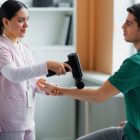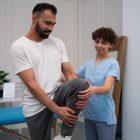Frozen shoulder, also known as adhesive capsulitis, is a condition that limits the range of motion of your shoulders due to the inability to rotate the shoulder joint properly. Stiffness and pain in the shoulder joint are the symptoms that characterize frozen shoulder, which gradually worsens over time and then eventually subsides. Age and gender are a few of the determining factors as you are at higher risk of getting frozen shoulder if you are a woman and fall under the age group of 40 to 60 years.
Causes
Frozen shoulder occurs when the tissue surrounding the shoulder joint called shoulder capsule thickens and restricts the movement of the shoulder joint by tightening around it. The chances of someone getting frozen shoulder heightens in those who had to immobilize their shoulder for a long time. Certain diseases like diabetes, tuberculosis, cardiovascular disease, and more can also increase the risk of developing frozen shoulder in an individual. Prolonged immobility of the shoulder as a result of a stroke, broken arm, recovery from surgery also puts you at the risk of getting frozen shoulder.
Symptoms
Dull and achy pain along with stiffness in your shoulders are the main symptoms associated with frozen shoulder. The magnitude of pain can worsen during the night affecting your sleep adversely and thus hindering the daily life activities. There are three phases that one experiences, each having unique symptoms and timeline.
- Freezing Stage
Shoulder pain elicited every time you move your shoulder characterizes this stage. The pain worsens over time, especially during the nights and can last anywhere from 6 to 9 months. The movement of your shoulder is restricted.
- Frozen Stage
At this stage, the pain might subside to an extent, but the stiffness in your shoulder joint gets worse. Daily activities also become challenging to perform as the movement of the shoulder becomes an arduous task. This stage can last from 4 months to 12 months.
- Thawing Stage
This stage can take anywhere from 6 months to 2 years to happen and marks the movement of the shoulder joint going back to normal gradually.
Diagnosis
A physical exam is the part of the diagnostic process where the doctor will examine the severity of the pain you are experiencing along with the range of motion of your shoulder joint. There are two phases to the exam- active and passive. The active phase will require you to move your shoulder on your own. On the other hand, during the passive phase, the shoulder movement will be assisted by the doctor to note the differences. In some cases, the doctor might inject your shoulder with anaesthesia to numb your pain and better judge your active and passive ranges of motion. Besides the physical exam, the doctor may also order other tests like X-rays, MRI and ultrasound for a better understanding of your condition and to rule out other problems with somewhat similar symptoms.
Treatment
Alleviation of pain and restoring the mobility of your shoulder joints is the objective of the treatment. The doctor can advise nonsteroidal anti-inflammatory drugs like aspirin and ibuprofen to reduce pain and inflammation. If NSAIDs doesn’t work, the next step prescribed by the doctor can be corticosteroid injections to reduce pain. The doctor might also employ physical therapy in certain stages of frozen shoulder wherein shoulder-specific exercises can be recommended. For shoulder expansion and stretching, the doctor can perform a procedure called joint distention wherein sterile liquid will be injected into the shoulder joint. When the usual methods of frozen shoulder treatment don’t work, which is very rare, surgery might be the next and last option advised by the doctor.
A visit to an orthopaedic clinic can be beneficial in reducing the pain and discomfort one experiences after developing frozen shoulder. At Orthocure Clinics, we provide integrative and all-encompassing treatment for your orthopaedic conditions where surgical options are not enforced on patients until required. We make use of advanced techniques and technologies to resolve your musculoskeletal problem so that you can go back to your normal life without any pain and discomfort. Depending on the severity of the condition and the requirements of the patient we employ non-surgical or conservative methods of treatment like chiropractic care as a part of the personalized healthcare we provide.
Disclaimer
This information should not be used as a substitute for professional diagnosis and treatment as this is for informational purposes only. One must consult their healthcare provider before making any healthcare decisions. Any damage, loss or injury suffered by an individual as a result of reliance on the information contained on this site is neither the responsibility nor the liability of Orthocure Clinics.





